Mazda fits CX-30 between CX-3 and CX-5
By John Gilbert
As purchasers of a vast array of automobiles, we in the U.S. have lost track of what passes for new technology. Some manufacturers spend more on advertising campaigns than on building better cars, because they are so addicted to bottom-line profits that they’re content to try to convince a naive public that the low-tech equipment they’ve restyled is actually the high-tech cars we seek.
Then there’s Mazda, a comparatively tiny manufacturer based in Hiroshima, Japan, but is loaded with brilliant engineers who not only stay on the cutting edge of technology but push the limits of what is possible to do with an automobile engine, while keeping its prices within reach of the average consumer, and also insisting that its cars maintain the simple belief that driving should be fun — embodied in the catch-phrase “Zoom-Zoom.”.
I recently got a chance to test-drive a Mazda CX-30 compact SUV, and it had so many advanced technical goodies built into it that I wasn’t sure what all it had.
Mazda already has an award-winning string of SUVs, from the compact CX-3, to the CX-5, and on up to the largest CX-9, and all of them over-achieve their targets. It didn’t seem that there wasn’t much of a gap between the smallest CX-3 and the CX-5 to squeeze another SUV between them, but Mazda thought differently. The CX-30 is right there, and sure enough, Mazda knew best, because the CX-30 relieves the concern that the CX-3 is almost but not quite big enough and that the CX-5 offers more room than a small family might need. The CX-5 is 179 inches long and the CX-3 measures 168 inches long, while the new CX-30 measures 173 inches in length — 5 inches longer than the CX-3 and 6 inches shorter than the CX-5.. The CX-30 wheelbase is 104.5 inches, 2.1 inches less than the CX-5.
I’m quite certain that anyone who considered either the CX-3 or CX-5 would find the CX-30 just right. Same with its pricer. It starts at the bargain rate of $21,900, although the test car was loaded up with what Mazda calls its Premium Package, which zooms the sticker up to $28,200 — still a bargain, particularly when you hear its ingredients.
It is fun to drive, quick and agile, and would probably be even quicker with only front-wheel drive. The test car had Mazda’s exceptional all-wheel drive, which may aid handling in the dry and certainly will in the wet or snow.
A couple years ago, Mazda engineers completed a decade of plotting, planning and developing to make its Zoom-Zoom go around corners even better than its standard of excellence in handling. To over-simplify, the idea of turning abruptly to go around a left turn, for example, common sense tells us we want to stiffen the outside wheel’s suspension and maybe give it an extra dose of power. Nay nay, says Mazda. Its engineers found exactly the opposite — if you start to turn in to the left and the power is reduced to the outside right front while its suspension is also softened just a bit, both for just a millisecond or two, you as the driver are emboldened that you’ve made the right choice to turn in at that spot.
You never feel anything because it’s too quickly executed, but in fact, if you are a good and competent driver you will notice one astounding difference: You almost never, if not never, have to correct the steering wheel to get you back on the proper turning arc. You have become a much better driver, without doing anything. The turn-in point is attained with precision, the driver has more confidence, perhaps, but the big thing is that when you go around a race track 10 laps, or around two or three different blocks quickly to find a parking place, you shorten your routine from “turn, correct, over-correct, accelerate,” to merely “turn and go.”
My appreciation for Mazda’s G-Vectoring is that I maintain most accidents happen with imprecise steering, when a driver turns, senses he’s turned too far, and corrects to straighten out, which leads to possible over-correction and a challenge to controllability. But it doesn’t take a genius to realize that if you never have to correct, then you definitely never over-correct.
A few years before that 10-year project found its way into all Mazda vehicles, the Hiroshima company’s engineers decided that some companies were advancing with different methods of expertise, whether in combustion, valve-timing, tuning, or tolerances. So Mazda’s engineers threw away their quite excellent little engines and started over with a clean sheet of paper, designing all-new methods for building high-tech engines from the ground up. The result was the “Skyactiv” technology, which took advantage of precise valve-timing and operation, and applied various types of high performance and high-economy tricks.
The engineers knew that getting maximum power and efficiency required high-compression, so they tuned their new 4-cylinder engines to attain 13.1:1 compression ratios. They also knew that if you made economy-minded buyers buy a car that required premium fuel, savings would be lost because of the 40-50-cent increase in cost per gallon. So they worked some sort of black magic to design 13.1:1 engines that pulled together all the best techniques and called only for regular fuel. The first upgrade of the Skyactiv is the Skyactiv-X engine, which deploys a spark-controlled compression-ignition technique for still more power and higher fuel efficiency.
Supposedly that will all be introduced on the CX-30 that will be introduced first in Europe as a 2021 CX-30 at the end of calendar 2020.
I also read a couple of introductory articles on the CX-30 in respected car magazines, and throughout the entire articles there was no mention of the extreme technology that is now commonplace on Mazda engines.
The jewel that was delivered to me in Duluth, Minnesota, was wearing the company’s $595 optional Soul Red Chrystal Metallic paint. With proper restraint, I think that is the most dazzling factory paint job I’ve ever seen on a car. The red has such depth, you can look deep down into it to capture an almost-3D effect when the sun hits that metallic body.
Its engine has been enlarged to 2.5 liters, turning out 186 horsepower at 6,000 RPMs and 186 foot-pounds of torque at 4,000 RPMs. Sadly, to me, the high-revving 2.0 Skyactiv is no longer available on any Mazdas larger than the Mazda3 and CX-3. I’ve heard the corporate claims that the larger engine gets almost identical fuel economy to the 2.0, but in my tests, the 2.0 gets spectacular mileage and the 2.5 just OK fuel economy. On this test, the CX-30 gave me a high of 27 miles per gallon, and i would expect over 30 with the 2.0.
The 2.5 reportedly now offers cylinder deactivation too. But for the first time in my long test-reviewing career, I have so far been unable to secure information on whether the 2020 CX-30 has the intriguing spark-controlled compression-ignition.
So I tried to put all those details out of my mind and set out to just enjoy the classic sporty interior, with its black seats and trim, although I would suggest Mazda relook at the gloss black used so much for trim. Flat black reflects much less and leaves the drivers less-dazzled with style but also less bothered by the glare that can prevent you from making out the switchgear at a glance.
The test CX-30 came with all the safety and performance enhancements, such as dynamic stability with traction control, lane departure warning and assist, blindspot detection, radar controlled adaptive cruise control with stop-start, radar powered liftgate on the hatch — which opens to a large cargo area — and an impressive Bose Centerpoint 2 audio system with 12 speakers.
The seats are firm and comfortable, and the steering wheel not only feels just right in your grip, but the top arc of the wheel perfectly traces the curvature of the cowling over the instrument pod.
As usual, that all adds up to the parts all being tied together in a cohesive package of driving enjoyment, whether pushing it hard through some curves or cruising along the North Shore Drive of Lake Superior. Or find a cloverleaf and push it aggressively all the way around. You may not know, or care, about G-Vectoring, or Skyactiv-X engines, but you don’t need to know any of those details to wring full driving enjoyment out of the CX-30. But if you ever take one for a test drive, at least push it hard enough around a corner and pay full attention to notice that you didn’t have to correct your steering trajectory. It indeed makes you a better driver than you thought you were.


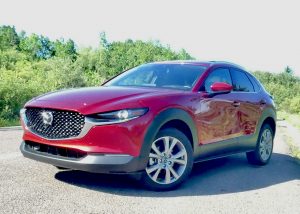
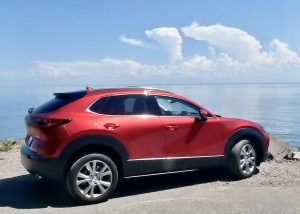
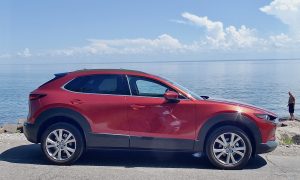
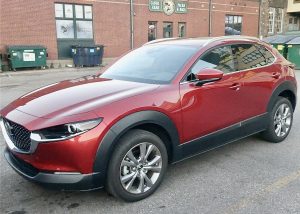
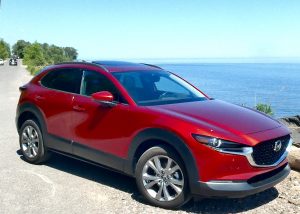
 John Gilbert is a lifetime Minnesotan and career journalist, specializing in cars and sports during and since spending 30 years at the Minneapolis Tribune, now the Star Tribune. More recently, he has continued translating the high-tech world of autos and sharing his passionate insights as a freelance writer/photographer/broadcaster. A member of the prestigious North American Car and Truck of the Year jury since 1993. John can be heard Monday-Friday from 9-11am on 610 KDAL(www.kdal610.com) on the "John Gilbert Show," and writes a column in the Duluth Reader.
John Gilbert is a lifetime Minnesotan and career journalist, specializing in cars and sports during and since spending 30 years at the Minneapolis Tribune, now the Star Tribune. More recently, he has continued translating the high-tech world of autos and sharing his passionate insights as a freelance writer/photographer/broadcaster. A member of the prestigious North American Car and Truck of the Year jury since 1993. John can be heard Monday-Friday from 9-11am on 610 KDAL(www.kdal610.com) on the "John Gilbert Show," and writes a column in the Duluth Reader.